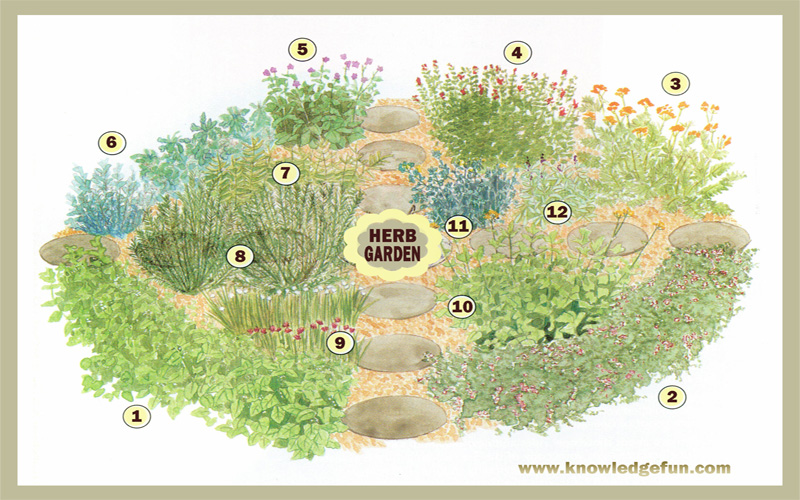This is an easy and creative plan for circle herb garden you can make in your backyard. I made a list of herbs for this herbal garden, but what to plant depends on your personal preference and needs, just make sure your herb garden is handy to the kitchen.
Growing herbs is surprisingly easy because they are by their very nature resistant to disease and insects. Herbs demand little attention, usually like sunshine and well drained sites bolstered with compost, but they are very forgiving in poor conditions.
Herb garden plan should start with an eight to nine foot radius circle divided into four equal quadrants by steping stones. You can put an ornamental sundial at the centre if you want or use some other decoration you prefer. Plant the tall specimens toward the centre and allow room for expansion.
List of Herbs:
1. LEMON BALM - A perennial relative of mint that has more fragrance than flavor. Crushed leaves provide fresh and persistent lemon aroma and flavor is sweet and subtly lemon scented with a light note of mint. Great for fish, poultry, stuffings, sauces and marinades. Tasty in desserts and cakes and excellent for salads.
2. THYME - This low growing perennial is without doubt one of the most important kitchen herbs. Thyme is one of the ingredients of a bouquet garni and has many culinary, medicinal and aromatic uses. Great for casseroles, stocks, sauces and soups. Perfect for mushrooms, eggplants, leeks, tomatoes, corn and dried beans.
3. CARROT TANSY - This perennial was used in the past as a strewing herb in butcher shops and houses to overpower less savory aromas. Today, it is used as natural insect repellent. Tansy repels mosquitoes, moths, flies, ants, cockroaches and bedbugs.
4. OREGANO - This famous herb popular in Italian cooking is a vigorous grower with a strong aroma. Oregano is traditionally used to flavor the popular Italian tomato sauce and tomato pulp which is spread on pizza dough, but it is also often used along the Mediterranean and all over the world. In Greece it is used for Greek salad, souvlaki, baked vegetables and baked fish. In Spain it is used in stews, with vegetables and in marinades.
5. BORAGE - An annual that thrives on light, dry soil with a light aroma and stronger taste of cucumber. Borage has long fuzzy leaves and star shaped flowers that look great floating on any creamy soup or beautiful garnish on a salad. Flowers can be also crystalized in syrup and used for desserts. Leaves are used in salads, dressings, sauces, pasta fillings and risotto.
6. ARTEMISIA ABSINTHIUM (WORMWOOD) - A vigorous grower that can be easily cultivated in dry soil needs a lot of space, so allow plenty of room. It is used for flavouring highly alcoholic beverage absinthe, and for flavouring some other spirits and wines, including bitters, bäsk, vermouth and pelinkovac. This plant is also used as medicine for dyspepsia, as a bitter to counteract poor appetite, and for various infectious diseases.
7. TARRAGON - This spicy-sweet perennial is native to western Asia and very popular in French cooking. Make sure you plant French not Russian tarragon because Russian has rank coarse flavor. French tarragon has warm and spicy taste of anise with a light touch of pepper. It is used to flavor many classic French sauces and it is excellent in vinegars and mustard. Use it with salads, asparagus, leeks, avocado, egg dishes, chicken, rabbit, scallops, lobster and crab.
8. ROSEMARY - A favorite perennial herb native to Mediterranean, grows best by the sea and in light dry soil. It is a very powerful, intensely aromatic herb and should be used in moderation. Rosemary is usually used to flavor a roast of veal or lamb, and in marinades for rabbit and game. It goes very well with fish such as sardines and mackerel.
9. CHIVES - This mildest and smallest member of the onion family are much like green onions, but more delicate. Chives have a pleasant light onion aroma and spicy onion flavor which is great addition to salads, dressings, egg dishes, soft cheeses and combined with other herbs. Garlic chives or Chinese chives have a distinctive garlic flavor and are great addition to many dishes.
10. LOVAGE - A tall perennial plant with a flavor similar to celery, but stronger and more piquant. This great herb gives body to variety of dishes and it is particularly good with beans, rice, vegetables, soups, tomato sauces and egg dishes.
11. RUE - This evergreen native to southern Europe is usually grown as an ornamental for its handsome blue-tinted leaves and bright yellow flowers. It has sharp spicy taste with a bitter and assertive aroma. It should be used with caution, in small amounts, because large amounts can be toxic. Usually used for marinades, herb vinegars and dry herb mixes.
12. SAGE - This small perennial bush, native to southern Europe, is a favorite culinary herb that grows best in dry soils. Sage is hardy plant that can survive in most north areas and usually retains its foliage into the winter, so you can still harvest it at Christmas. Sage has strong aroma so use it cautiously. Great for pork, lamb, duck, goose, stuffings, sauces, focaccia, polenta, in soups and cheese.


















